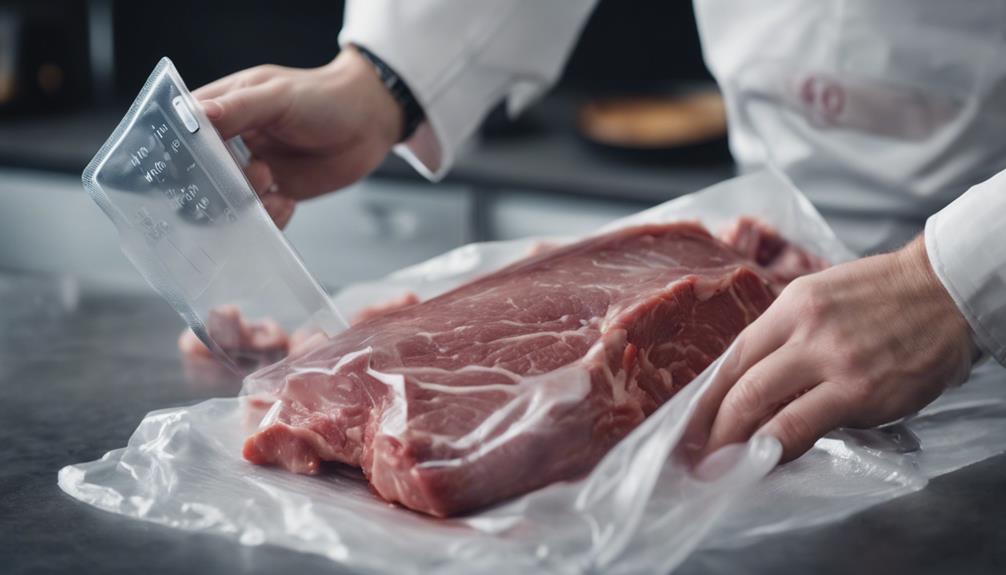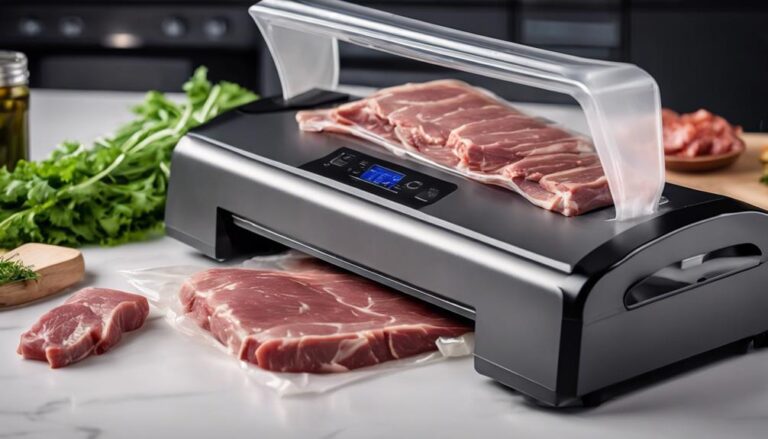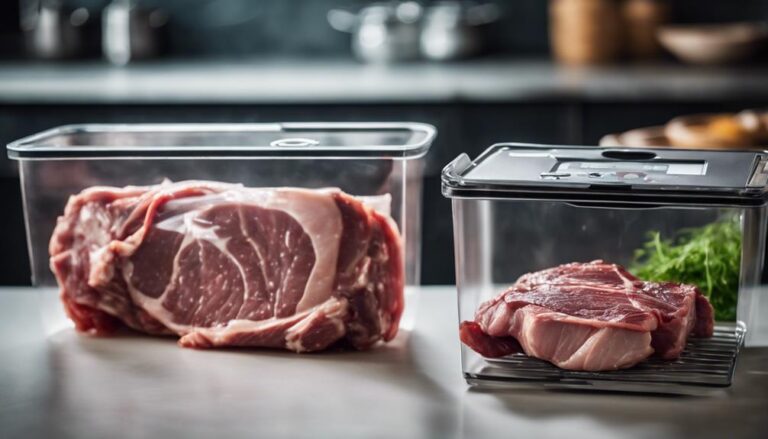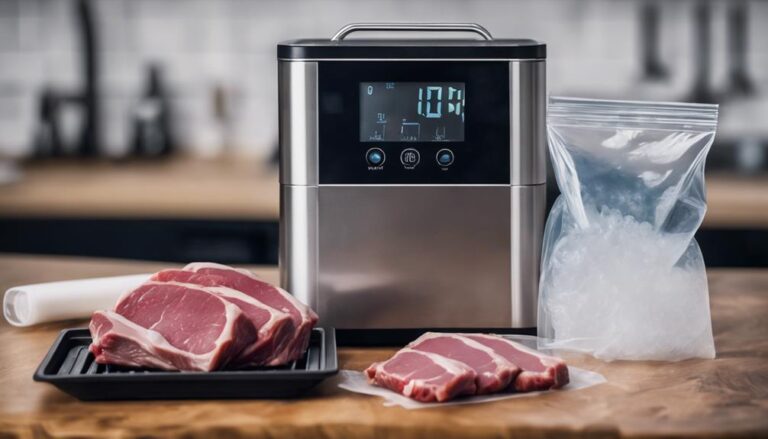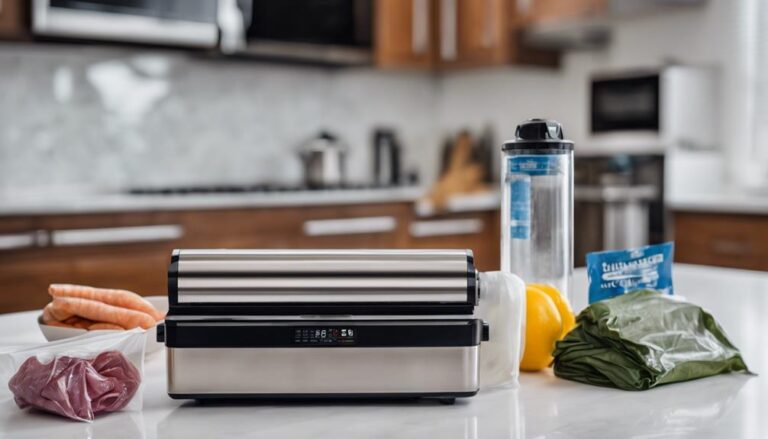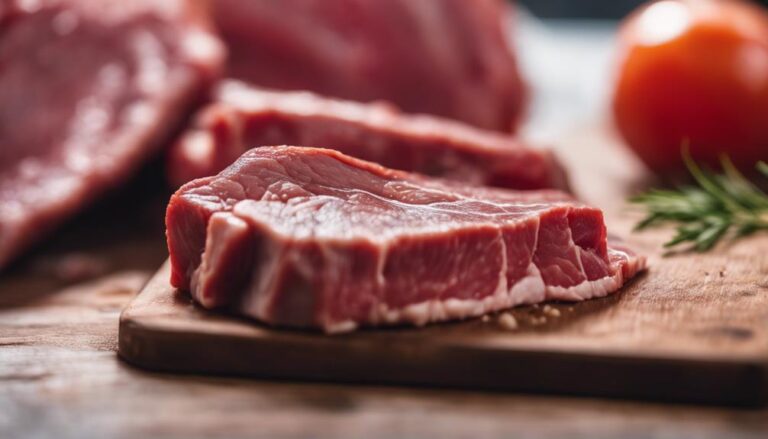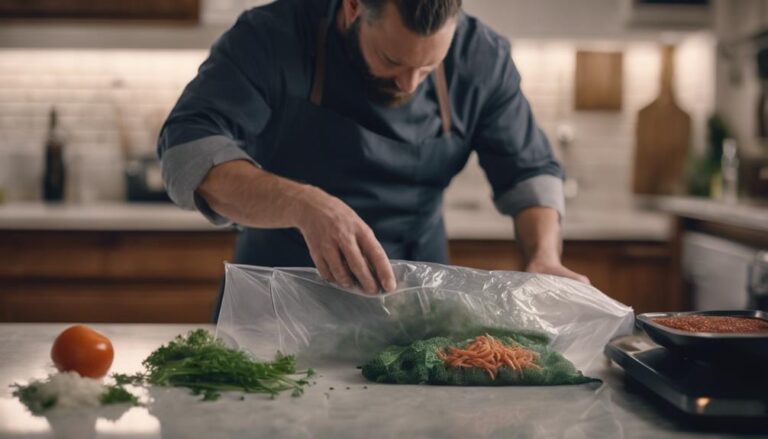Understanding Food Safety in Sous Vide Cooking
Hey there, sous vide enthusiast! Keep those culinary creations bacteria-free with a few food safety tips. To start, nail those temperatures; bacteria love the 40°F-126°F range, so aim for precision. Watch out for anaerobic bacteria lurking in low-temp pouches—quickly serve or chill to halt their party. Vacuum-seal like a pro to lock in flavors and textures. When cooking, follow guidelines religiously, especially with meats. And remember, cooling and reheating are your friends. Oh, and maintaining fridge chilliness is a must! Stay tuned for more pro tips on sous vide safety.
What You Will Learn Here
- Proper temperature control prevents bacterial growth.
- Vacuum-seal bags tightly to maintain food safety.
- Thorough pasteurization is crucial, especially with meats.
- Rapidly cool cooked food to minimize bacterial multiplication.
- Use a reliable food thermometer for accurate readings.
Importance of Food Temperature Control
Maintaining accurate food temperatures is essential in sous vide cooking to prevent bacterial growth. Think of it as a battle between you and those sneaky bacteria trying to crash your delicious dinner party. Cooking below 130°F might as well be playing nice with the bacteria because it won't get rid of them. These tiny troublemakers throw a party between 40°F and 126°F, so nailing that temperature control is your secret weapon.
Imagine your food as a VIP guest at a fancy gala. You leave them hanging out in the danger zone (40°F to 130°F) for too long, and suddenly, they're mingling with the wrong crowd. Regularly checking that circulator temperature with a second thermometer is like having your food's personal bodyguard, ensuring they stay safe and sound.
Risks of Anaerobic Bacteria Growth
To combat the risks of anaerobic bacteria growth in sous vide cooking, vigilance in handling vacuum-sealed pouches is paramount. Anaerobic bacteria, those little troublemakers that thrive without oxygen, just love to party in the safe, low temperatures of your sous vide pouches. It's like a cozy bacteria vacation in there!
But hold on a second, we don't want any unwanted guests crashing our food party. Extended cooking times at low temperatures can make these bacteria multiply faster than bunnies. So, what's the game plan? Be a food safety superhero! Properly handle those pouches, serve or chill your food pronto after cooking, and make sure your fridge is a chilly paradise below 41°F to slow down any spoilage organisms thinking of causing trouble.
Proper Vacuum-Sealing Techniques
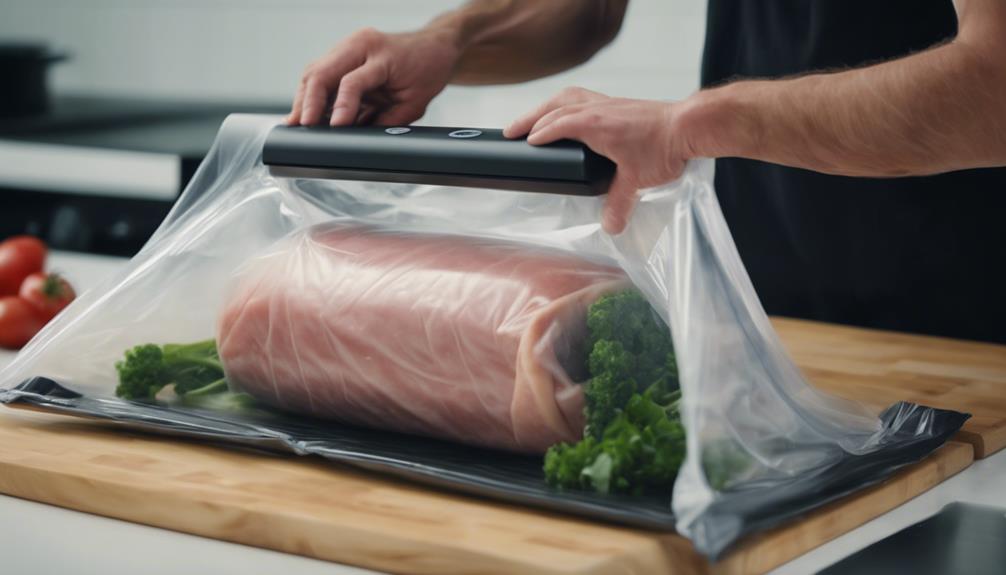
When vacuum-sealing your sous vide bags, make sure to seal them tightly to keep the goodness in!
Remember to squeeze out any sneaky air bubbles trying to ruin your meal.
Seal Bags Tightly
For optimal results in sous vide cooking, make sure your bags are tightly sealed using proper vacuum-sealing techniques. When you vacuum-seal your ingredients, you're not just pretending to be an astronaut; you're creating a snug little package that keeps flavors locked in and water out. Here's a useful table to help you grasp the significance of sealing your bags securely:
| Benefits of Secure Sealing | How to Achieve Strong Seals | Why It's Important |
|---|---|---|
| Preserves flavors, textures, and juices | Utilize a vacuum sealer or immersion methods | Prevents water from penetrating bags |
| Prevents uneven cooking | Ensure there are no air pockets in the bags | Avoids cross-contamination |
Remove Air Bubbles
Ensure your pouches are free of air bubbles by mastering proper vacuum-sealing techniques to enhance heat transfer and cooking consistency in sous vide preparation.
When vacuum-sealing your ingredients, make sure to smooth out the contents within the pouch to eliminate any pesky air bubbles that could ruin your culinary masterpiece. Those sneaky air pockets can mess with the cooking process, leaving you with unevenly cooked food – not exactly the high-quality experience you were aiming for!
By ensuring a tight seal and removing air bubbles, you're not only promoting even heat distribution but also preventing your food from playing peek-a-boo in the water bath.
Check for Leaks
To guarantee a secure seal and prevent leaks, carefully inspect the vacuum-sealed bags before placing them in the water bath for sous vide cooking. Nobody wants a soggy situation or a leaky disaster in their food storage, right?
So, before you start cooking, give those bags a good once-over. Check the temperature of the seal, make sure there are no sneaky leaks, and confirm everything is airtight. You don't want your delicious meal swimming around in the water bath like it's on a mini-vacation.
Keep an eye out for any fishy business — we mean leaks — throughout the cooking process. A tight seal means your food stays safe, sound, and delicious!
Guidelines for Safe Cooking Practices

To ensure utmost food safety in sous vide cooking, adhere to these essential guidelines for safe cooking practices.
When diving into the world of sous vide cooking, remember that proper temperatures are your best friend. Make sure your food reaches the recommended temperature to keep those pesky bacteria at bay.
Oh, and speaking of friends, always use vacuum-sealed bags specifically designed for sous vide cooking. They'll help maintain food safety and keep things airtight.
Now, when dealing with ingredients like chicken, steaks, or fish, don't rush the process – pasteurize thoroughly for that extra layer of safety. And here's a tip: keep a close eye on cooking times and temperatures. It's like babysitting your food, but hey, better safe than sorry, right?
Finally, once your culinary masterpiece is ready, cool it down fast and store it properly. This way, you'll minimize any chances of unwelcome bacteria crashing the party.
Monitoring Cooking Temperatures
When guaranteeing food safety in sous vide cooking, one critical aspect to focus on is monitoring cooking temperatures. Managing the temperature with precision is like being a conductor orchestrating a symphony of flavors in your sous vide dish.
Think of yourself as the captain of the temperature ship, guiding through the sea of bacteria to the safe harbor of perfectly cooked food. Using a reliable food thermometer is your dependable compass, leading you to the desired temperature for pasteurization. It's like having a food superpower – the ability to zap those harmful bacteria away with precise temperature control.
Imagine yourself as a temperature detective, constantly checking the circulator temperature with a second thermometer to ensure your cooking conditions are spot on. By sticking to recommended temperature ranges and cooking times, you're not just cooking; you're choreographing a culinary masterpiece that's both safe and delicious.
Role of Fresh Ingredients
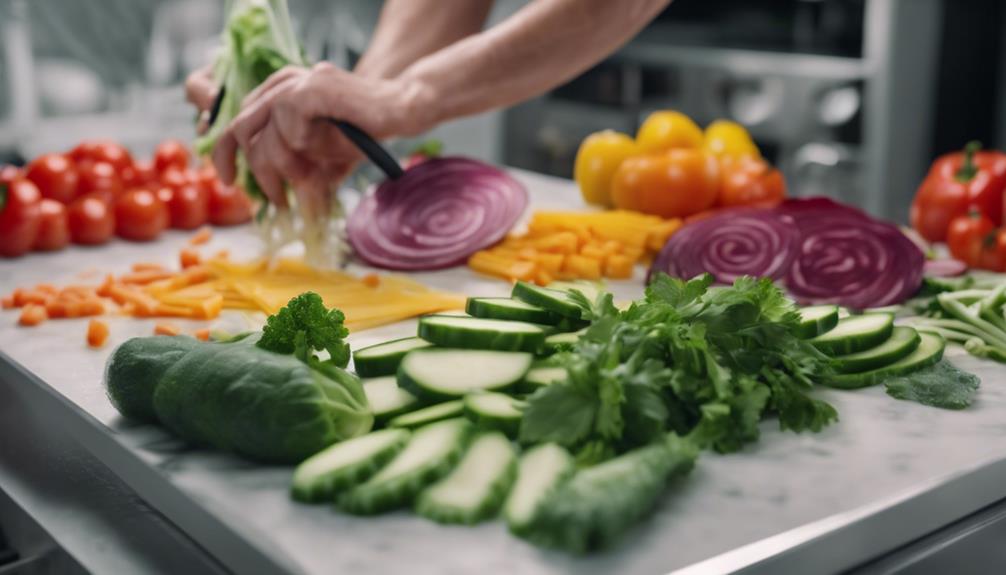
Fresh ingredients play an essential role in sous vide cooking, ensuring minimal off-flavors and maximizing taste quality. When you use fresh meats, poultry, or fish in your sous vide dishes, you're setting yourself up for success. These solid pieces not only pasteurize thoroughly during cooking but also retain their natural flavors beautifully. To help you visualize the importance of fresh ingredients for even cooking, take a look at this table:
| Fresh Ingredients Benefits |
|---|
| Minimize off-flavors |
| Ideal taste quality |
| Thorough pasteurization |
| Retain natural flavors |
| Enhance even cooking |
Ensuring Prompt Serving or Chilling
Relying on proper handling techniques after cooking is crucial for maintaining food safety in sous vide cooking. Imagine this: you've just finished cooking your delicious sous vide meal to perfection. Now, what's next?
Well, my friend, it's time to either serve that dish promptly or chill it like a boss! One way to go is to explore the concept of rapidly serving your culinary creation. By getting that food from the sous vide bath to the plate quickly, you're basically telling any potential bacteria, 'Nope, not today!'
Another cool trick up your sleeve is using an ice bath. Visualize this: your hot, perfectly cooked meal takes a quick dip in an ice bath before hitting the fridge. It's like giving your food a rejuvenating spa day, cooling it down quickly and keeping those pesky microbes at bay.
Key Steps in Maintaining Food Safety
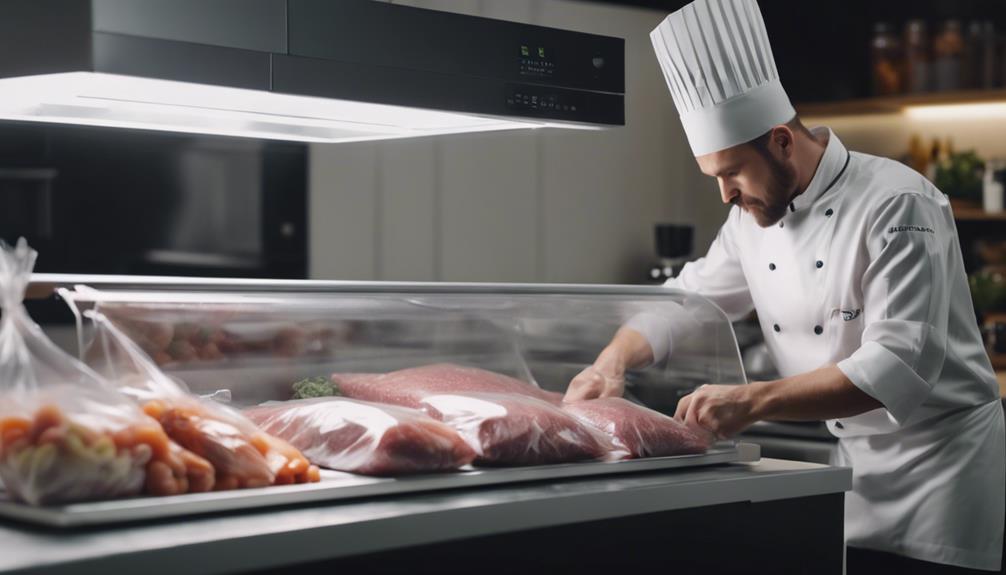
To guarantee food safety in sous vide cooking, correctly pasteurizing foods like chicken and blade-tenderized steaks is crucial. This process ensures that harmful bacteria are eliminated, leaving your meals safe to enjoy.
After cooking, remember to cool your food rapidly. It's like giving those bacteria a chill-pill – they won't have time to throw a party in your food.
When you're ready to serve, make sure to thoroughly reheat your delicious sous vide creations. This final heat blast will bid farewell to any lingering bacteria that might want to crash your culinary masterpiece.
Labeling and informing your enthusiastic diners about proper storage, reheating, and temperature checks are also key steps in this food safety tango.
And hey, when you're sealing your ingredients in those vacuum-packed pouches, opt for fresh, solid pieces of meat, poultry, or fish. This way, you're ensuring a thorough pasteurization process and minimizing any risks lurking around in your sous vide adventure.
Understanding Contamination Risks
To understand contamination risks in sous vide cooking, proper handling and temperature control are paramount. When cooking sous vide, you're creating a cozy little environment where bacteria can throw a party if not kept in check. Low temperatures over long periods can make those bacteria multiply faster than rabbits on a spring day. So, what's the secret sauce to keeping these microscopic party crashers at bay? Well, it's all about handling your food like a pro. Make sure to serve or chill your cooked goodies pronto to stop bacteria from spreading like gossip at a high school reunion.
Keeping your fridge as chilly as your ex's heart at 41ºF or colder helps slow down any ingredient rebellion in your sous vide creations. And don't forget your trusty food thermometer – it's your kitchen sidekick in ensuring that your food hits those safe temperatures. So, in the epic battle for food safety in sous vide cooking, remember: handle with care, chill like a villain, and always be temperature-wise.
Frequently Asked Questions
What Is the Safety of Sous Vide Cooking?
In sous vide cooking, you control the temperature precisely with sous vide equipment. The pasteurization process eliminates bacteria. When vacuum sealing, make sure proper guidelines are followed for food safety. Stick to these rules to enjoy safe and delicious sous vide dishes.
When Cooking Sous Vide What Are the Food Safety Challenges Chefs Face?
When cooking sous vide, chefs face food safety challenges like temperature control to prevent pathogen growth and ensuring proper pasteurization processes to avoid foodborne illnesses. Maintaining these standards is essential for safe cooking practices.
What Categories of Bacteria Can Be a Hazard in Sous Vide Cooking?
When cooking sous vide, be aware of bacterial risks like Clostridium botulinum, Listeria monocytogenes, and Salmonella. Maintain temperature control and proper handling to prevent pathogen growth. Remember, bacteria like E. coli and Campylobacter can pose food safety risks.
What Are the Disadvantages of Sous Vide Cooking?
Sous vide cooking brings challenges like longer cooking times affecting texture. Equipment maintenance and precise temperature control are essential. Initial costs for immersion circulators may deter quick meal enthusiasts. Achieving caramelization levels like other methods can be debated.
Conclusion
So, remember folks, when it comes to sous vide cooking, it's all about keeping things cool, sealing the deal, and serving up safety with a side of deliciousness.
By following proper temperature controls, vacuum-sealing techniques, and fresh ingredient guidelines, you'll be on your way to culinary success without the risk of any unwanted bacteria crashing the party.
Stay safe, stay savvy, and most importantly, stay hungry for more sous vide adventures!
